A History of the County of Bedford: Volume 3. Originally published by Victoria County History, London, 1912.
This free content was digitised by double rekeying. All rights reserved.
'Parishes: Ampthill', in A History of the County of Bedford: Volume 3, ed. William Page (London, 1912), British History Online https://prod.british-history.ac.uk/vch/beds/vol3/pp268-275 [accessed 19 April 2025].
'Parishes: Ampthill', in A History of the County of Bedford: Volume 3. Edited by William Page (London, 1912), British History Online, accessed April 19, 2025, https://prod.british-history.ac.uk/vch/beds/vol3/pp268-275.
"Parishes: Ampthill". A History of the County of Bedford: Volume 3. Ed. William Page (London, 1912), British History Online. Web. 19 April 2025. https://prod.british-history.ac.uk/vch/beds/vol3/pp268-275.
In this section
AMPTHILL
Ammetulle, Anthill.
The parish of Ampthill lies some 7 miles south of Bedford. It covers an area of 1,904 acres, of which 134 acres are woodland. (fn. 1) The parish is beautifully situated, and has extensive views from the high wellwooded ground in the middle parts of it. The little town of Ampthill lies in a sheltered hollow at the meeting of four roads—namely, one to Shefford, which in the town is called Church Street; one to Dunstable, called Dunstable Street; one to Woburn, called Woburn Street (fn. 2); and one to Bedford. The market, which is held on Thursdays, was established in 1219 by grant to Nicholas Poinz and Joan his wife. (fn. 3) It was confirmed to Joan Albini in 1242, who at the same time received a grant of a fair here on the vigil, feast and morrow of St. Mary Magdalene. (fn. 4) The principal part of the town lies around the market-place at the west end of Church Street, which has undergone considerable changes during the last 130 years. Formerly there were houses 'standing incommodiously in the market place,' which were pulled down in 1785, and a pump and obelisk erected in their place by the Earl of Upper Ossory. There was a moot hall here, which perhaps indicates some kind of town organization, possibly by a gild of which we have no information. Parry (fn. 5) describes the hall as being a good building surmounted by a cupola and clock, but Lysons (fn. 6) writes disparagingly of it, calling it 'a mean old room.' The honour courts were held in it till about 1823, (fn. 7) but it was afterwards demolished and a block of buildings erected in 1852 occupies the site. The county court hall in Church Street, where the courts are held every two months, has taken its place. The clock tower, however, still remains, in which there are two bells, the first inscribed 'R. C. made me 1710,' and the other 'Richard Chandler made me 1701.'
Opposite to the block of buildings erected on the site of the moot hall is the Compass Inn, a small hostel having a rough-cast front, though the walls of the archway leading into the yard at the back are of half timber filled in with brickwork laid herringbone fashion. The building, whose front is now in process of demolition, may date from the 16th century.
There are several other inns dating from the 18th century, the most interesting being the 'King's Arms.' It is a three-story building faced with purple-coloured bricks (similar to those used at Leighton) with red brick dressings, while half-timber construction may be seen at the back. The staircase is a very fine open one with well-moulded balusters, while the room on the left of the entrance is lined with panelling taken from an earlier building. In the yard at the back is a two-story half-timber building, now used as a cyclerepairing shop, the upper part of which is plastered over. A panel on the wall bears the date 1677, a raised fleur de lis being placed between the six and the seven, while over the date are the initials W. H. separated by a small crown. The White Hart Inn in the market-place probably stands on the site of that of the same name existing in the 16th century. The other inns of the 18th century are of little interest architecturally. Of these the 'King's Head' and the 'George' are on the Woburn road, the former standing at the corner, while the 'Prince of Wales' and the 'Crown and Sceptre' are on the road to Bedford.
There are several chapels, the Wesleyan and Union ones being in Dunstable Street.
Many of the inhabitants are employed in the brewery of Messrs. Morris & Co.
It seems probable that the cloth industry was carried on here in the Middle Ages, as there was a small colony of Flemings then resident in the town. (fn. 8)
The church stands about 100 yds. east of the market-place on the north side of the road to Shefford, and is approached from a small square, in the middle of which stands a clump of large evergreens. On the east side of the approach are the Feoffee Almshouses, built of brick with a facing of rough-cast, and having a modern four-centred brick archway leading through to the back with carved stone spandrels. They are roofed with tiles and are two stories high, with picturesque gabled dormers in the upper story.
The town was evidently in a prosperous state in the 18th century, as is shown by the many buildings of that date which line the streets, the majority being built of brick and having tile roofs. Among the larger ones are Dynevor House, formerly known as Paunfort Lodge, the residence of the Misses Wingfield, standing at the west corner of the Shefford Road and the approach to the church, a large red brick house of three stories, with three windows on either side of a central entrance door. It has a wellmoulded brick cornice supporting a parapet of the same material, while on two rain-water pipes are ornamental lead heads bearing the initials S.U. and the date 1725, in which year it was built by Sir Simon Urlin. On the opposite side of the Maulden road to the church stands 'Foulislea,' a fine 18th-century red brick house of three stories with a central projecting bay carried by a stone porch with Ionic columns. There are two windows in each story on either side of this bay. The rusticated quoins and the cornice and the porch are painted over, as are also the keystones and sills to the windows. The house, which is surmounted by a high brick parapet, contains a fine oak staircase. On the opposite side of the road is a large red brick house with a walled garden in front above the level of the roadway, and on the garden wall is a very good 18th-century wrought-iron railing with central entrance gates, while at either end are fine brick piers surmounted by stone cornices and vases. To the west stands a two-story red brick house of slightly later date, having a very good stone porch with Doric columns. On the east side of the Flitwick Road are two twostory 18th-century brick houses having pretty little wooden doorways of the Doric order carrying triangular pediments. Many of the older buildings, though faced with brick, are of half-timber construction at the back.
In the early part of the 19th century many stage coaches passed through the town, which was prosperous and 'reckoned the genteelest town in the county.' (fn. 9) The opening of the railway at first had the effect of taking away from the prosperity of the town, and owing 'to the death of various persons much respected in the town it lost much of its distinctive character.' (fn. 10) Ampthill station (on the main line of the Midland Railway Company) is situated about a mile from the town. The town is now extending along the road leading to it. The road from Ampthill to Woburn on the west of the town runs along the top of a ridge and is remarkable for the fine views to be obtained from it. On its north side are a number of semi-detached cottages. They are very picturesque, some being built of half timber and brickwork with thatched roofs, while others are covered with rough-cast. They are known as the 'Duke's Cottages' and bear early 19th-century dates (1813, 1815 and 1816) over an earl's coronet. Opposite these the road widens out, while an avenue of lime trees known as the 'Alameda,' running south-west, leads to a pine wood. These trees were planted by the celebrated Lady Holland in imitation of the Almeida at Madrid. On the land formed by the widening of the road at the end of the 'Alameda' the cattle fair is held in the first week of May and last of November.
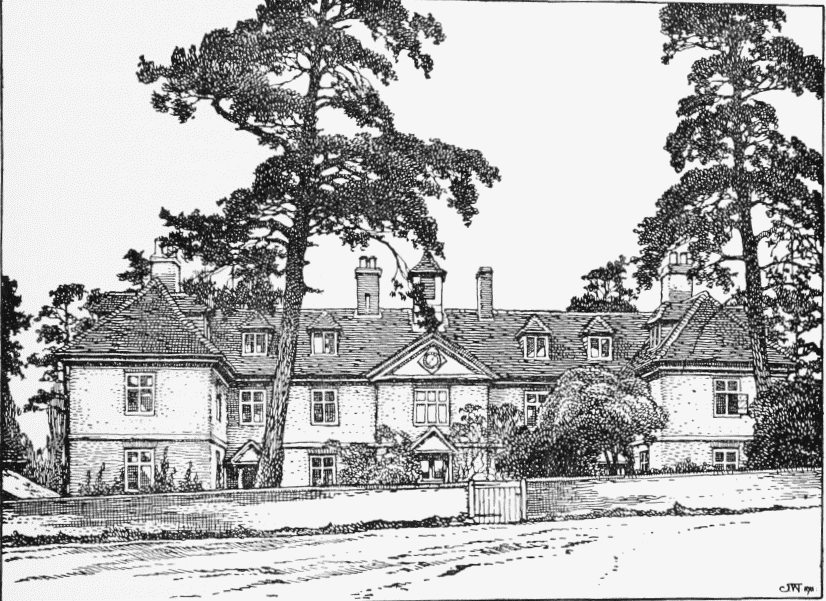
The Oxford Hospital (John Cross's Almshouses).
From here a footpath leads through Cooper's Hill spinney to the almshouses erected by John Cross late in the 17th century. They make a delightfully picturesque two-story block of red brick buildings, with dormers in the tiled roof lighting the attics. They front north and south and are E-shaped in plan, the roofs of the projecting end wings being hipped back, while the central block, which is only of very slight projection, has a triangular pediment. A flat brick string-course marks the firstfloor level, while a well-designed wooden cornice carrying a gutter marks the junction at the wall head level. In the pediment of the central gable is a clock face, while over this is a small bell-turret. The almshouses, which provide accommodation for eight men and four women and a matron and reader, are entered on the ground floor through two doorways on the south front, one at either end of the main block, having gabled hoods covered with tiles and carried on carved brackets. In the centre bay a large doorway with a projecting hood of a similar character gives access into a small chapel, lighted from the back. Between the entrances and the chapel on either side is a two-light window divided by wooden transoms and mullions, while a similar window is placed in the middle of the end blocks. On the first floor, centred over each window or porch, is a window like those on the ground floor except that the window over the chapel doorway is of three lights, while in the roof of the main block are four dormer windows immediately above the windows below. The sides and back are lighted in the same way, the windows being placed symmetrically along the walls and immediately over one another, while four chimney stacks are carried up, one on either side of the bell-turret and one at each end at the intersection of the ridge of the main block with those of the projecting wings. A brick wall surrounds the building, with a garden at the back.
The chief glory of Ampthill, however, is its park, which contains some of the largest oak trees in England. A great storm which swept over the county in 1796 did much damage to these trees. (fn. 11) A survey taken in the time of the Commonwealth condemned some 287 of them as unsound and unfit for navy purposes. (fn. 12) At the present day many are hollow and shattered, requiring support, but the immense girth of their trunks witnesses to their past magnificence. In the time of Henry VIII there were two parks in Ampthill known respectively as the Great Park (fn. 13) and the Little Park. They were kept well stocked with deer and afforded good sport to the king, who paid frequent visits to Ampthill between the years 1524 and 1532. (fn. 14) During the reign of Elizabeth the stock of game in the park declined. (fn. 15) Lord Elgin having leased the property was licensed by Charles I to preserve game there, and the persistent hunting and hawking of Richard Conquest (fn. 16) and his brothers in the preserves made it necessary for the king to interfere in protection of the earl's interests. (fn. 17) During the Commonwealth the Great Park suffered greatly, the game being decimated. Charles II accordingly disparked it and presented the remaining deer to John Ashburnham, to whom he also leased the park itself for a rent of £100. (fn. 18)
When Sir John Cornwall was lord of Ampthill Manor in the early part of the 15th century he built himself a 'faire castle' there out of the spoils of the French wars. (fn. 19) The area of this castle was a square of about 220 ft. In front was a large court 115 ft. by 120 ft. Behind this were two very small ones, each 45 ft. square, and between these was an oblong courtyard. Between the front and back courts the building had two small lateral projections, like the transepts of a church. In front were two square projecting towers, and round the building at irregular distances nine others, principally five-sided octagons. (fn. 20) Later after the castle had become royal property Henry VIII stayed there on his hunting expeditions. He was fond of the place, and wrote from there (to Wolsey) in 1528 thus: 'I and my people are well ever since we came to Ampthill on Saturday last, in marvellous good health and clearness of air.' (fn. 21) Henry afterwards placed the castle at the disposal of Catherine of Aragon, and here she resided during the divorce proceedings. (fn. 22) By the end of the century the castle had fallen into decay. The site of it (on the top of a well-wooded ridge in the park) is now marked by a stone cross put up in 1770 standing on an octagonal base of three steps. The shaft is octagonal, the base being richly diapered, while below the head, the arms of which have carved ends, is a shield bearing the arms of Castile and Aragon, the royal arms impaling quartered a lion rampant and castle. On one face of the base are the following lines, said to be by Horace Walpole:—
In days of old here Ampthill's towers were seen,
The mournful refuge of an injured Queen;
Here flowed her pure but unavailing tears,
Here blinded zeal sustain'd her sinking years.
Yet Freedom hence her radiant banner wav'd,
And Love aveng'd a realm by priests enslav'd;
From Catherine's wrongs a nation's bliss was spread,
And Luther's light from Henry's lawless bed.
The present house at Ampthill Park is situated at the foot of the hill and was built by Lord Ashburnham in 1694. (fn. 23) Lord Upper Ossory later had the brick surface of the walls encased in a substance resembling stone after the classical style. (fn. 24) It was leased from the Duke of Bedford for some years by Sir James Parke, Baron Wensleydale, (fn. 25) the well-known judge, who died there in 1868. (fn. 26) Since 1885 it has been the residence of Emily Lady Ampthill.
The main building faces north-west and is of three stories, but has lower projecting side wings. The front is of stucco and has a slightly projecting central bay crowned with a triangular pediment and having a cornice which runs round the building; the roof of the main block is of tiles, the side wings being covered with slate. The central entrance is approached by a flight of stone steps, the doorway being set between two Ionic columns carrying a broken curved pediment in which is an antique bust. The wall is pierced by a range of large sash windows. The building, although imposing in its vastness and situated in a fine position, is somewhat tame in design. Facing the house and resting on a high pedestal sculptured in stone is the figure of a dog represented with its head in the air in the act of baying.
Standing in well-wooded grounds, in the garden of which are some artificial ponds, is Ampthill House, the residence of Mr. Anthony Wingfield, approached from the south side of the Maulden road through a carriage drive a few yards to the east of the church. It is a comparatively modern brick building having a projecting Doric portico of rather sturdy proportions. The former house on this spot was the residence in the 17th century of the Nicolls family, who acted as keepers of the parks under the Bruces. Robert Nicolls, the Governor of Long Island, was born here. He led an adventurous life, passing much of his time abroad. He was in command of the British force that drove the Dutch from New York, and met his end fighting against the Dutch at Sole Bay in 1672. (fn. 27) The cannon ball which caused his death is still preserved in the church imbedded in a tablet to his memory, which proclaims it as instrumentum mortis et immortalitatis.
An interesting incident connected with the Civil War occurred at Ampthill in the autumn of 1643. A party of 'well affected' gentry having met in committee in the town, their deliberations were rudely disturbed by the arrival of Sir Lewis Dyves, the leading Royalist of the county, with a body of royal horse. Sir Lewis made the members of the committee his prisoners and carried them away to Oxford. (fn. 28)
This parish was inclosed in 1806. (fn. 29)
HONOUR
The honour of Ampthill was created by Act of Parliament in 1542. (fn. 30) It was a royal honour, and had annexed to it the king's manors and lands in Ampthill, Millbrook, Flitwick, Maulden, Steppingley, Westoning, Houghton Conquest, Wilshamstead, Lidlington, Husborne Crawley, Ridgmontcum-Segenhoe, Aspley Guise, Clophill, Shefford, Cranfield, Pulloxhill, Harlington, Toddington, Barton, Shillington, Chalgrave, Marston, Woburn, Eversholt, Milton Bryant, Warden, Elstow, Cauldwell, Dunstable, Salford, Holcot, Bedford, Wootton and Colmworth in Bedfordshire, and Newport Pagnell, Tickford, Moulsoe, Great Linford, Little Linford, Stewkley, Little Brickhill, Bow Brickhill, Wavendon, North Crawley and Swanbourne in Buckinghamshire. (fn. 31) Out of the profits of the honour Henry VIII made provision for Anne of Cleves. (fn. 32) James I settled it on the Prince of Wales, (fn. 33) who in turn assigned it as portion of the dower of Queen Henrietta Maria, (fn. 34) who enjoyed the profits until the outbreak of the Civil War. (fn. 35) In the time of the Commonwealth the honour was bought by Colonel Okey the regicide. (fn. 36) On the Restoration the dues of the honour once more were paid to Henrietta Maria, who still enjoyed them in 1671. (fn. 37) After her death the honour was let on a long lease to Thomas Bruce Earl of Ailesbury, whose family had filled the office of seneschal of the honour since the resignation of Viscount Fentoun in 1613. (fn. 38) It remained in the hands of the Earl of Ailesbury until 1730, when it was sold by him to the Duke of Bedford. (fn. 39) Francis the ninth Duke of Bedford bought up the outstanding rights of the Crown in 1881. (fn. 40)
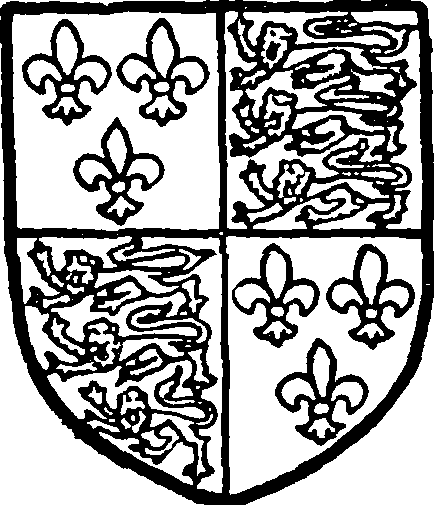
The King of England. Azure three fleurs de lis or, for France, quartered with Gules three leopards or, for England.

Russell, Duke of Bedford. Argent a lion gules and a chief sable with three scallops argent therein.
MANORS
In the time of Edward the Confessor Ampthill was held by seven sokemen, who could assign and sell their land to whom they wished. (fn. 41) William I granted the manor to Nigel Albini, of whom it was held in 1086 by Nigel de Wast. (fn. 42) It was then assessed at 5 hides and valued at £4. (fn. 43) The estates of Nigel de Wast subsequently escheated to the lords of the fief, (fn. 44) but before the year 1219 Nicholas Poinz and Joan his wife had been enfeoffed of it. (fn. 45) They held a weekly market there for which they paid 5 marks to the king. (fn. 46) Soon afterwards the manor appears to have again escheated, and Joan Albini, the daughter and co-heir of Robert Albini, was granted a yearly fair there in 1242. (fn. 47) The manor, together with property in Millbrook, was held by service of one and a-half knights' fees. (fn. 48) Joan Albini died without issue, and her property was divided between her two sisters Isabel and Asseline. (fn. 49) The bulk of the Ampthill property went to Asseline, but one-fourth of the manor, rather more than a carucate of land, fell to Isabel's share, and will be treated of first. Isabel was married to William de Hocton, but at the time of her death she was known as Isabel Albini, (fn. 50) and her son William, who succeeded her, appears to have taken his mother's maiden name. (fn. 51) He died in 1263, (fn. 52) leaving as his heirs three daughters: Isabel, Christine and Joan. (fn. 53) Though the heirs of all three claimed to have manorial rights in Ampthill in 1330, (fn. 54) the descendants of the eldest daughter Isabel alone appear to have exercised them. The latter was twice married, first to Hugh de St. Croix and later to William de Hotot, with whom she held (fn. 55) the property in 1302–3. (fn. 56) Her husband survived her until 1310, when the property passed to Peter de St. Croix, Isabel's son by her first husband. (fn. 57) He held until his death in 1349. (fn. 58) His son and heir Robert died the same year, leaving an heir Thomas, a child under age. (fn. 59) The king granted the wardship to Roger Beauchamp, (fn. 60) who received the profits of the property until Thomas de St. Croix reached his majority in 1362. (fn. 61) The latter made a life grant of this portion of the manor to Sir John Cheyne the next year, (fn. 62) while his successor John de St. Croix alienated it in 1366 to Almaric de St. Amand, the holder of the remainder of the manor. (fn. 63)
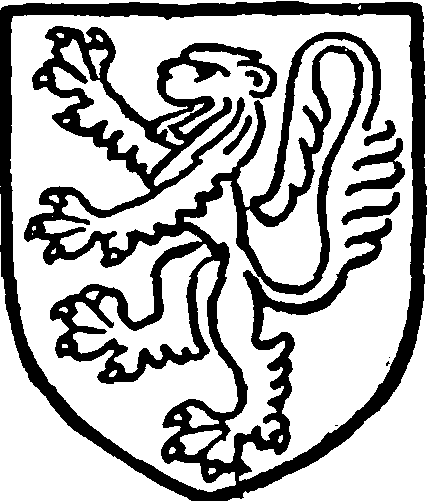
Albini. Gules a lion or.
To return to the division of the manor on the death of Joan Albini, Asseline the wife of Ralph St. Amand received the greater portion. She was succeeded by her son Almaric St. Amand, (fn. 64) and he by his son John, who was holding in 1316. (fn. 65) The latter's son Almaric, together with Peter de St. Croix, claimed a view of frankpledge in Ampthill, rights of free warren and weekly market, and a yearly three days' fair in 1330. (fn. 66) Soon afterwards Ampthill market was suppressed by proclamation, but on the representations of Eleanor de Keynes, who farmed the vill during the minority of Almaric's heir John St. Amand, it was restored, as the profits of the vill were insufficient without the market dues. (fn. 67) John St. Amand was succeeded by his son Almaric, who, as seen above, became seised of the outstanding quarter share of the manor in 1366. He was re-enfeoffed of the manor in conjunction with his wife Eleanor in 1402 (fn. 68) and died in 1403. (fn. 69) His wife, who survived him, made over the manor to Walter Pygeon, John Goldington and others, (fn. 70) who later enfeoffed Sir John Cornwall Lord Faunhope of the same. (fn. 71) Sir John Cornwall previous to his death placed the manor, then valued at £30, in the hands of Nicholas Assheton and other trustees. (fn. 72) After his death, which occurred in 1443, (fn. 73) the manor was claimed by two persons, Ralph Lord Cromwell, who sued Nicholas Assheton for not selling the manor to him in accordance with Sir John Cornwall's will, (fn. 74) and Henry Duke of Exeter, whose stepmother had married Sir John Cornwall. (fn. 75) Nicholas Assheton placed the manor in the hands of William Bishop of Lincoln and others, (fn. 76) and the case between the claimants was submitted to the arbitration of Thomas Bouchier. (fn. 77) In whose favour judgement was given is uncertain, but it seems probable that the Duke of Exeter obtained the manor. (fn. 78) He was a zealous Lancastrian and forfeited his property in 1461. (fn. 79) Edward IV, after the battle of Northampton, granted Ampthill Manor to Sir Edmund Grey, later created Earl of Kent. (fn. 80) The latter's grandson Richard de Grey, owing the king large sums of money, sold him the manor in 1508. (fn. 81) This appears, however, to have been but a temporary arrangement, and after he had dissipated his estate and died his half-brother Sir Henry Grey had seisin of the manor, (fn. 82) and alienated it to three courtiers, Richard Wingfield, Henry Wyat and Richard Weston, in 1523–4 (fn. 83); from these it passed into the hands of the king, and became the principal manor in his new honour of Ampthill created in 1542. (fn. 84) It remained royal property until 1677, when Charles II leased it to Robert Earl of Ailesbury for ninety-nine years, (fn. 85) and until 1800 it followed the same descent as the honour of Ampthill (q.v.). Charles II had previously (1661) granted a portion of the demesne lands later known as Ampthill Park to John Ashburnham. (fn. 86) These lands remained in the hands of the Ashburnham family until 1720, when they were bought from them by Lord Fitz William, (fn. 87) who sold them to Lady Gowran in 1736. (fn. 88) The latter was succeeded by her son, who was created Earl of Upper Ossory in 1751, (fn. 89) and he by his son the second earl, who was lord lieutenant of the county from 1771 to 1818. (fn. 90) In 1800 the latter exchanged his manor of Lidlington for the manor of Ampthill, to which latter these lands became again attached. (fn. 91) On his death in 1818 the manor passed to his nephew Lord Holland, (fn. 92) from whose widow it was purchased in 1842 by the Duke of Bedford. (fn. 93) It has remained in the hands of the Dukes of Bedford down to the present day.
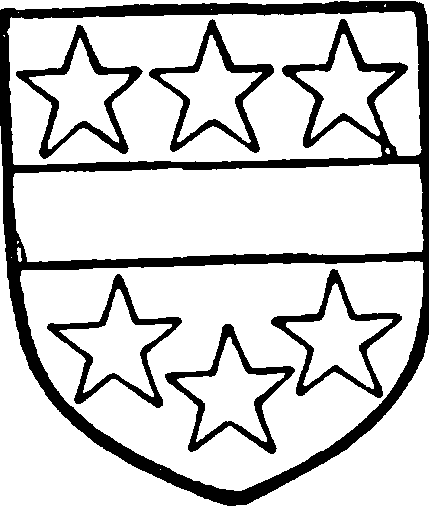
Ashburnham. Gules a fesse between six molets argent.
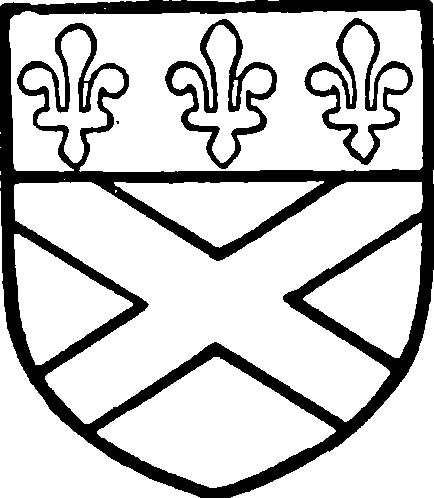
Fitzpatrick, Earl of Upper Ossory. Sable a saltire argent and a chief azure with three fleurs de lis or therein.
The grange of LYMBOTSEY or LIMERSEY, with its rich pasture lands, was in the possession of the Abbot of Warden by the end of the 12th century, (fn. 94) and probably by grant from the Albini family. The abbot claimed rights of free warren over this land in 1330. (fn. 95) The value of this property in 1291 was £4 6s. 4d., (fn. 96) and at the time of the dissolution of the monasteries it was valued at £5 6s. 8d. (fn. 97) Elizabeth made a temporary grant of it to Richard Pickman, (fn. 98) while Charles I made it over to James Beverley, (fn. 99) lord of the manor of Clophill and Cainhoe. (fn. 100) Though no further mention of it has been found, its further history is probably the same as that of this manor (q.v.). The grange was evidently on the eastern border of the parish with its pastures extending into the adjoining parish of Maulden, as 'Limersey' is still a place-name in that part of the parish.
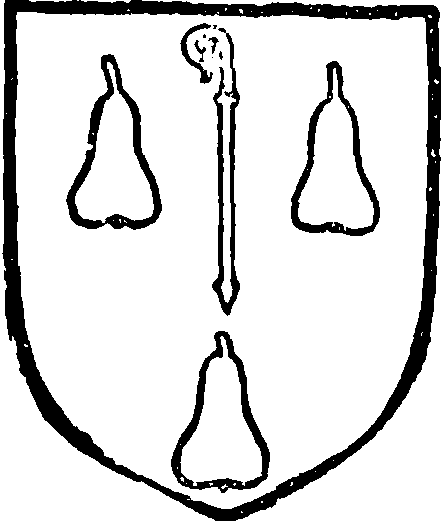
Warden Abbey. Azure a crozier between three pears or.
CHURCH
The church of ST. ANDREW consists of a chancel 32 ft. by 18 ft., with a modern north vestry and organ chamber, a nave 49 ft. 10 in. by 19 ft., north aisle 9 ft. 8 in. wide, south aisle 10 ft. 3 in. wide, south porch and west tower 12 ft. 10 in. by 14 ft. 7 in.
The nave arcades and chancel arch date from c. 1330, but both aisles seem to have been rebuilt in the next century. The porch is also of the 15th century, as is the west tower, which, owing to lack of space westward, has been made to overlap the west respond of the arcade. The chancel is set at a different axis from the nave, and is very irregularly planned. The chancel arch is not central either with the nave or the chancel; it may have been narrowed on the north side to make room for a rood stair, the place of which is taken by a modern pulpit. The chancel was probably rebuilt in the 15th century, and may then have been widened southward. Externally nearly all the stonework of the windows and buttresses is new, and, all the windows of nave and chancel being of a somewhat uninteresting 15th-century type, the exterior is rather dull. The nave arcades are, however, very good work, though lacking the length and dignity of Houghton Conquest or Northill, and have arches of two wave-moulded orders with a label, and quatrefoiled piers with rolls in the angles and moulded capitals and bases. The nave clearstory is 15th-century work with four twolight windows on each side. The roofs are all of low pitch with plain 15th-century detail, having at the intersections of the beams in nave and aisles angels holding shields, repainted in clumsy and ignorant fashion, the heraldry in many being meaningless.
The tower arch is in three orders, of which the outer is hollow-chamfered and the others plain chamfered, with 15th-century moulded capitals and bases. There are galleries in both aisles, and the modern font stands under the tower, the west door of which is built up. The south porch is of two stories, but all its details are renewed. There is a small late piscina recess in the south aisle. The tower is embattled, with diagonal buttresses and a stair turret at the north-east angle; over the blocked west door is a three-light window with clumsy tracery, probably a 17th-century patching reproduced in modern stonework; the windows of the bell-chamber are of two cinquefoiled lights with quatrefoils over.
At the east end of the north aisle is a Purbeck slab set upright, and on it a brass figure and inscription to Sir Nicholas Harvey, 1532, with his arms On a bend three trefoils, a molet for difference, quartering a lion rampant in a border gobony. This brass was for a time moved to Northill Church but was lately returned. At the west end of the nave are fixed on boards the brasses of William Hicchecok, 'wolman,' merchant of the Staple of Calais, 1450, and his wife Agnes; also those of John Barnhard, chapman, 1506, and Ellen his wife; and the inscription of John Lodyngton, 1485, with the figure of his wife. There is also an inscription dated 1460 as follows:
Maker of Man, O God in Trinite
That hast allone all thing in ordññce,
Forgeve the trespas of my juvente
Ne thynke not Lord up on myn ignorance.
Forgeve my soule all my misgoverññce,
Bryng me to blisse where thon art Eternall,
Ever to joye with his aungeles celestiall.
Five of the bells were recast in 1898, and the sixth was given by Mr. R. Fielder in 1900.
The plate consists of a plated cup and paten dated 1774 and a silver paten of the same date, a modern cup and paten and a modern plated flagon and cup.
There are six books of registers previous to 1812: —(1) all entries 1604 to 1650; (2) 1653 to 1668; (3) 1669 to 1699; (4) 1684 to 1749, in various portions; (5) 1750 to 1812, except marriages; (6) marriages 1779 to 1812.
ADVOWSON
The advowson of Ampthill Church was granted by Henry D'Albini to the priory of Beaulieu at the time of its foundation (1140–6). (fn. 101) On the dispersal of the property of the priory in the 15th century the advowson of Ampthill was bought by Sir John Cornwall, (fn. 102) who died seised of it in 1436. (fn. 103) Its further history is the same as that of the manor (q.v.). The value of the church in 1291 was £4 6s. 4d., (fn. 104) whilst at the Dissolution the rectory was valued at £10 6s. 6d. (fn. 105).
Hugh Reeve, rector of Ampthill in the reign of Charles I, roused the hostility of his congregation by 'his popish doctrines and practices.' On petition he was deprived of his living and parsonage and granted a pension of £10, but, instead of being grateful, he defied the order and refused to leave the parsonage, whereupon the people of Ampthill petitioned that his pension might be cancelled. (fn. 106)
The commission of 1547 to inquire into chantry foundations reported that there were two tenements in Ampthill, of the yearly value of 13s. 4d., which had been granted for the maintenance of an obit in the parish church. (fn. 107)
CHARITIES
The following charities have by a scheme of the Charity Commissioners, 5 January 1906, been amalgamated under the title of the United Charities, namely, the charities of:—
1. John Bryan, for poor widows; will, 4 August 1655; trust fund, £225 9s. 2d. consols.
2. William Carter; will, 19 August 1703; rentcharge of £2 10s. issuing out of Canal Close.
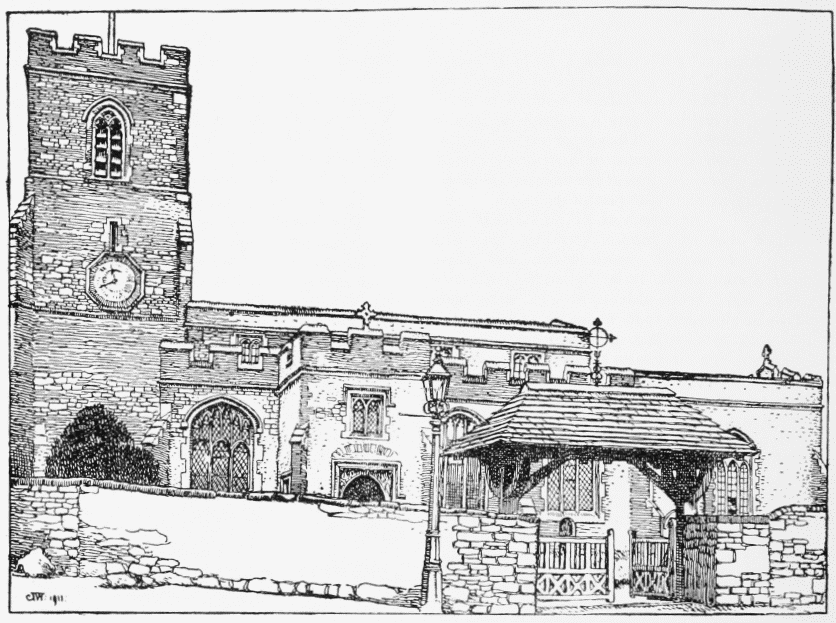
Ampthill Church from the South.
3. The coal charity (otherwise the Poor's Allotment or the workhouse charity), comprised in an inclosure award, 16 March 1808; endowed with three houses in Park Hill, and known as the Old Workhouse, let at £25 a year, and 10 a. 2 r. 13 p. in Flitwick, known as the Moor, let at £6 a year.
4. Elizabeth Croson; will, proved at Northampton 1 September 1902; trust fund, £103 4s. 6d. London County 3 per cent. stock.
5. Mary Ann Patten; will, proved at Northampton 31 December 1883; trust fund, £48 18s. 11d. consols.
6. Charles Richards; will, 11 July 1724; (a) for bread, trust fund, £83 12s. 8d. consols; (b) for clothing, a rent-charge of £4 10s. issuing out of Willow Close and Maggotts Moor.
7. Arthur Wichalse; will, 14 October 1687; trust fund, £188 8s. 6d. consols. (See under Maulden.)
The several sums of stock are held by the official trustees, producing yearly dividends amounting to £16 14s. 8d.
By the scheme the real estate is vested in the official trustee of charity lands, and the charities are to be administered by the rector for the time being and two other trustees appointed by the urban district council.
In 1909 clothing was given to five poor widows in respect of charity no. 1, overcoats to three old men in respect of no. 2, 3 cwt. of coal to each of 193 recipients in respect of no. 3 and 4, dressmaking materials in respect of no. 5, 180 loaves distributed and clothing to six recipients in respect of no. 6, and the income of no. 7 was in course of being accumulated.
The official trustees also hold a sum of £25 15s. 1d. consols, producing 12s. 8d. a year, in respect of the above-mentioned John Bryan's charity, for a sermon, of which the rector and churchwardens were in 1906 appointed to be the administering trustees.
In 1691–2 Elizabeth Emery, in performance of the will of her sister, Sarah Emery, conveyed to trustees a messuage and certain lands in the parish of Wilshamstead, now a farm containing 17 a., let at £28 a year, upon trust to apply one moiety of the income for educational purposes in Ampthill and the other moiety for the like purposes in the parish of Meppershall.
The administration of the charity is regulated by a scheme of the Charity Commissioners, dated 5 July 1901.
In 1740 the Rev. George Wateson by deed gave an annuity of £5, issuing out of land in Foundry Lane, for teaching children to read and instruction in the catechism. The annuity has been redeemed by the transfer to the official trustees of £166 13s. 4d. India 3 per cent. stock, who also hold £28 13s. 2½ per cent. annuities, representing the redemption of a charge of 1s. a year on the glebe land.
By a scheme of the Charity Commissioners, 6 May 1892, the income is applied towards the expenses of the Sunday school and school prizes.
The Feoffee or Charity Estate, comprised in certain ancient deeds, was in 1819 the subject of proceedings in Chancery, and in the result the charity estates were by deed, dated 16 April 1822, conveyed to trustees upon trust for the use and benefit of industrious poor of Ampthill and Maulden, subject to the regulations respecting the application and management settled by the court and annexed by way of schedule to the deed.
By an order of the Charity Commissioners, 31 July 1903, new trustees were appointed, the trust estates then consisting of almshouses in Church Street, 5 a. 1 r. 16 p. near Pinfold Hill, and a small piece of land in Woburn Street, Ampthill, 6a. 1 r. 36 p. known as Russell's Close, and 12 a. 2 r. 6 p. known as Greene's Closes, in the parish of Maulden, and 3 r. 9 p. in Abbey Lane in Maulden, purchased in 1892 for £100, of the aggregate rental value of £95.
The official trustees also hold £2, 778 9s. 9d. consols, producing £69 9s. a year, arising from sales of house property and land in Ampthill and of land at Duck End in Maulden and compensation from the Midland Railway Company.
In 1909 the sum of £85 16s. was applied in weekly payments to the almspeople, £5 for medical attendance, £4 secretary's salary, and £16 15s. in repairs, and there was a sum of £101 12s. 6d. in the Savings Bank.
In 1899 Marianne Eagles by will bequeathed £105 for providing coals for the almspeople. The legacy is represented by £93 12s. Metropolitan 3½ per cent. stock, with the official trustees, producing £3 5s. 4d. a year, which was applied in gifts of coal to the twelve inmates of the Feoffee Almshouses.
The hospital founded by will of John Cross of the University of Oxford, dated 23 November 1697, is situated in this parish. The trust is now regulated by a scheme of the Charity Commissioners, 28 July 1874, whereby the Vice-Chancellor of the University of Oxford, the Dean of Christ Church, the Warden of All Souls' College, the Regius Professor of Divinity and the Regius Professor of Civil Law, and two elective trustees were constituted the body of trustees. The trust estates consist of the Hospital, the Little Park Farm, containing 298 acres or thereabouts, let at £300 a year, and Deep Hall, now part of University College, Oxford, producing £15 a year, certain funds in Court, from which in 1909 a sum of £128 7s. was received in dividends; also £4,703 London and North Western Railway 3 per cent. debenture stock and £2, 950 Great Western Railway 5 per cent. stock, held by the official trustees, producing in dividends £288 11s. 10d. a year.
The gross income in 1909 was £730.
The scheme directs that the net income, after providing for the payment of £10 assigned by the founder to the trustees for their care and trouble and £5 for anniversary orations in memory of Dr. Fell, shall be applied in the maintenance and support of the almshouses and their officers (including a chaplain), the almspeople to consist of nine men and four women, single and not below sixty years of age, who are to receive not less than 8s. and not more than 12s. a week.
In 1909 the payments and allowances to the inmates amounted to £359 4s. 6d., payments to pensioners £62 5s., and the officers' salaries £140 4s.